#FarmManagementSoftware
Explore tagged Tumblr posts
Text
Take your farm management to the next level with Agmatix’s innovative farm management software. Optimize resources, boost productivity, and make data-driven decisions with real-time insights and advanced analytics.
Start revolutionizing your farm today with Agmatix!
0 notes
Text
Agriculture ERP's Role in Unlocking Growth
Written By: Jagriti Shahi
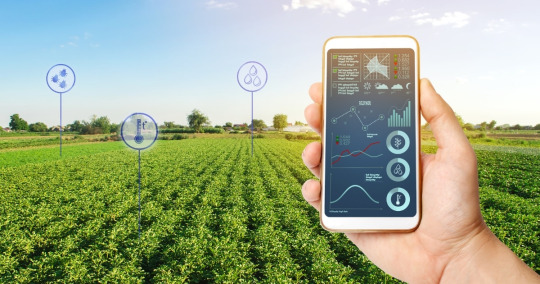
Introduction
India, with its vast and diverse agricultural landscape, has been embracing technological advancements to modernize its farming practices. One such pivotal development is the implementation of Agriculture Enterprise Resource Planning (ERP) infrastructure. This integrated system is designed to streamline and optimize various agricultural processes, from production and supply chain management to financial transactions and data analysis. In this article, we will explore the significance and impact of Agriculture ERP infrastructure in India. India, a country deeply rooted in its agricultural heritage, is on the cusp of a transformative journey in farming practices, driven by technological advancements. At the heart of this evolution is the implementation of Agriculture Enterprise Resource Planning (ERP) infrastructure. This integrated system is not merely a digital tool but a comprehensive solution designed to revolutionize every facet of the agricultural supply chain. From the intricacies of crop planning to the intricacies of financial transactions, ERP infrastructure is reshaping the landscape of Indian agriculture. In this article, we delve into the significance, features, and profound impact of Agriculture ERP infrastructure in propelling India towards a future of sustainable and technologically-empowered farming.
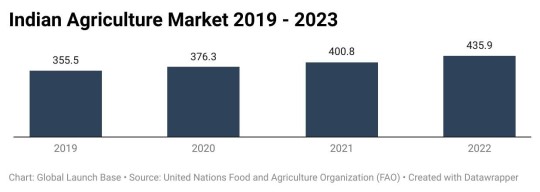
Figure: Indian Agriculture Market Size - 2019 - 2023
India's agricultural sector, a cornerstone of the nation's economy, is undergoing a digital transformation. At the heart of this change lies Agriculture Enterprise Resource Planning (ERP) systems. But how ready is the current infrastructure for widespread ERP adoption, and how can ERP companies prepare for the unique landscape of Indian agriculture?
The Current Landscape: A Patchwork of Potential
India's agricultural infrastructure presents a complex picture. While some regions boast modern facilities and tech-savvy farmers, others struggle with limited internet connectivity, fragmented land holdings, and a lack of digital literacy. This digital divide creates a challenge for widespread ERP implementation.
However, there are reasons for optimism. Government initiatives like Digital India and Krishi Megh (Farmers' Cloud) are promoting digital literacy and rural internet connectivity. Additionally, the rise of affordable smartphones and mobile apps is bridging the gap for many farmers.
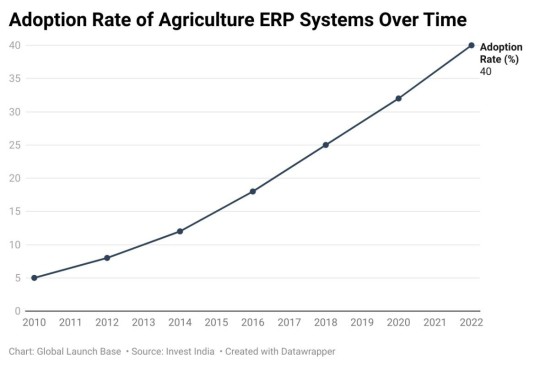
Figure: Adoption Rate of Agriculture ERP Systems Over Time
This figure indicates the percentage of agricultural businesses in India that have adopted ERP systems during each corresponding year.

Figure: Forecasted Growth of Agriculture ERP Market
The Need for Agriculture ERP in India
India's agriculture sector has traditionally been characterized by small-scale farming practices, fragmented land holdings, and manual labor. The introduction of ERP systems aims to address several challenges faced by the agricultural community, such as inefficient resource utilization, lack of real-time data, and limited access to market information. By leveraging technology, the Agriculture ERP infrastructure seeks to enhance productivity, increase efficiency, and ultimately boost the income of farmers.
Key Features of Agriculture ERP in India
Crop Planning and Management: ERP systems enable farmers to plan and manage their crops effectively by providing real-time data on weather conditions, soil health, and market demand.
Crop management modules assist in optimizing planting schedules, crop rotations, and resource allocation, leading to improved yield and reduced wastage.
Supply Chain Integration: Seamless integration of the supply chain is a critical component of Agriculture ERP. It facilitates efficient coordination between farmers, suppliers, distributors, and retailers.
Real-time tracking of produce from farm to market ensures transparency, reduces wastage, and minimizes losses during transportation.
Financial Management: ERP infrastructure helps farmers manage their finances by providing tools for budgeting, expense tracking, and revenue forecasting.
Access to credit facilities and insurance options is enhanced, empowering farmers to make informed financial decisions and mitigate risks.
Market Intelligence: The ERP system gathers and analyzes market data, enabling farmers to make informed decisions based on current market trends and demand.
Access to market intelligence helps farmers negotiate better prices and explore new markets for their produce.
Data Analytics and Precision Farming: Data analytics tools incorporated in Agriculture ERP systems enable farmers to make data-driven decisions.
Precision farming techniques, aided by ERP infrastructure, allow for optimized resource utilization, leading to increased efficiency and reduced environmental impact.
Benefits and Impact
Increased Productivity: By providing farmers with timely and relevant information, Agriculture ERP infrastructure contributes to enhanced productivity through optimized crop planning and resource utilization.
Improved Profitability: Efficient supply chain management, access to market information, and financial planning tools contribute to increased profitability for farmers.
Sustainable Agriculture: Precision farming practices promoted by ERP systems promote sustainable agriculture by minimizing resource wastage and environmental impact.
Empowering Farmers: Agriculture ERP infrastructure empowers farmers by providing them with the tools and knowledge to make informed decisions, access financial resources, and navigate the market effectively.
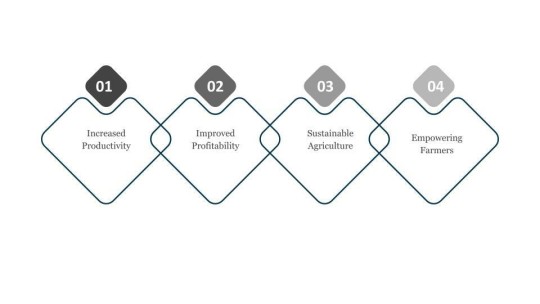
Challenges and Future Prospects While Agriculture ERP infrastructure holds immense potential, challenges such as the digital divide, infrastructure limitations, and resistance to technology adoption must be addressed. The government, private sector, and agricultural communities need to collaborate to overcome these hurdles and ensure the widespread adoption and success of ERP systems in Indian agriculture.
In conclusion, the implementation of Agriculture ERP infrastructure in India represents a significant step towards modernizing the agricultural sector. By leveraging technology to enhance efficiency, productivity, and sustainability, these systems play a crucial role in transforming traditional farming practices and improving the livelihoods of millions of farmers across the country. As India continues on its path of agricultural development, the integration of ERP infrastructure will remain a key driver of positive change in the sector.
Challenges of India's Infrastructure Landscape
India, as one of the world's fastest-growing economies, faces a myriad of challenges in its infrastructure development. Despite significant progress in recent decades, the country grapples with persistent obstacles that hinder the efficient functioning and expansion of its infrastructure networks. Understanding these challenges is crucial for policymakers, investors, and stakeholders to devise effective strategies for addressing them and unlocking India's full growth potential.
1. Funding and Financing Constraints: One of the primary challenges facing Indian infrastructure development is the availability of funding and financing. Infrastructure projects often require substantial capital investment, and securing long-term financing on favorable terms remains a significant hurdle. Issues such as regulatory uncertainties, project delays, and high debt burdens deter both domestic and foreign investors, constraining the pace of infrastructure expansion.
2. Bureaucratic Red Tape and Regulatory Hurdles: India's bureaucratic processes and regulatory frameworks are often cited as major impediments to infrastructure development. Cumbersome approval processes, overlapping jurisdictional authorities, and complex legal requirements contribute to project delays and cost overruns. Streamlining regulatory procedures, enhancing transparency, and promoting ease of doing business are essential for expediting infrastructure projects and attracting investment.
3. Land Acquisition and Rehabilitation Challenges: Land acquisition remains a contentious issue in India, particularly for large-scale infrastructure projects. Conflicting land ownership claims, inadequate compensation mechanisms, and resistance from local communities pose significant hurdles to acquiring land for infrastructure development. Moreover, the displacement of people and disruption of livelihoods necessitate comprehensive rehabilitation and resettlement policies to mitigate social tensions and ensure equitable development outcomes.
4. Technological and Innovation Gaps: While India has made strides in adopting modern technologies and innovation in certain sectors, there remains a significant gap in infrastructure development. Outdated construction methods, inadequate use of digital technologies, and limited innovation in project design and execution hamper the efficiency and quality of infrastructure projects. Embracing emerging technologies such as artificial intelligence, blockchain, and Internet of Things (IoT) can enhance project management, optimize resource utilization, and improve infrastructure resilience.
5. Sustainability and Environmental Concerns: With rapid urbanization and industrialization, India faces mounting environmental challenges associated with infrastructure development. The depletion of natural resources, air and water pollution, and ecological degradation threaten both human well-being and ecosystem integrity. Balancing the imperative for infrastructure expansion with environmental sustainability requires integrating green infrastructure solutions, promoting renewable energy sources, and implementing stringent environmental regulations and standards.
6. Transportation and Connectivity Bottlenecks: Inadequate transportation infrastructure and connectivity remain significant barriers to India's economic growth and development. Congested roadways, insufficient public transportation systems, and underdeveloped rail and air networks impede the efficient movement of goods and people. Addressing transportation bottlenecks requires investments in road and rail infrastructure, last-mile connectivity solutions, and multimodal transportation hubs to enhance mobility and facilitate trade and commerce.
7. Urbanization and Infrastructure Deficits: India's rapid urbanization places immense pressure on urban infrastructure systems, exacerbating existing deficits in housing, water supply, sanitation, and public services. The proliferation of informal settlements, inadequate urban planning, and insufficient infrastructure investments contribute to urban sprawl, congestion, and social inequalities. Adopting integrated urban development strategies, promoting affordable housing initiatives, and investing in smart city infrastructure are imperative for creating sustainable and inclusive urban environments.
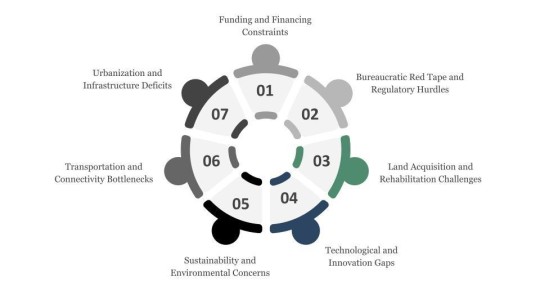
Addressing the multifaceted challenges of India's infrastructure landscape requires concerted efforts from government agencies, private sector entities, civil society organizations, and other stakeholders. Embracing innovation, fostering public-private partnerships, streamlining regulatory processes, and prioritizing sustainability are essential for overcoming barriers to infrastructure development and unlocking India's vast growth potential. By addressing these challenges holistically and collaboratively, India can build resilient, inclusive, and sustainable infrastructure networks that propel the nation towards a prosperous future.
Are Indian Farmers ready for using ERP?
The readiness of Indian farmers to adopt Enterprise Resource Planning (ERP) systems varies based on several factors, including technological literacy, access to resources, and awareness of the benefits of digital solutions. While some farmers may be ready and willing to embrace ERP technology, others may face significant barriers to adoption. Let's explore both perspectives:
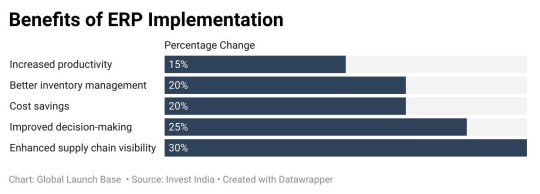
Figure: Benefits of ERP Implementation
Reasons for Optimism:
Government Initiatives: Digital India and Krishi Megh are bridging the digital divide and promoting rural internet access and digital literacy.
Mobile Revolution: Affordable smartphones and mobile apps are making information and tools more accessible to farmers.
Early Adopters: Progressive farmers are already reaping the benefits of ERP, demonstrating its potential.
The Reality:
Indian farmers are at various stages of ERP readiness. Large-scale, tech-savvy farms are prime candidates, while smaller farms might require more accessible and affordable solutions.
Factors Contributing to Readiness
Technological Awareness: Many Indian farmers, particularly those in regions with better access to information and communication technologies (ICTs), are increasingly familiar with digital tools and platforms. They may already use mobile applications for accessing weather forecasts, market prices, and agricultural information, indicating a level of readiness for more advanced technological solutions like ERP.
Education and Training: Farmers who have received formal education or vocational training in agriculture and allied fields are more likely to understand the benefits of ERP systems and possess the necessary skills to operate them effectively. Training programs conducted by government agencies, NGOs, and private organizations can enhance farmers' readiness by imparting knowledge about ERP functionalities and best practices.
Access to Connectivity: The availability of reliable internet connectivity, particularly in rural areas, is crucial for the successful adoption of ERP systems. With the increasing penetration of mobile networks and initiatives like BharatNet aimed at expanding broadband connectivity to rural India, farmers have greater access to online resources and digital platforms, laying the foundation for ERP adoption.
Market Integration: Farmers engaged in commercial agriculture and value-added activities are more likely to recognize the importance of efficient management practices and technology-driven solutions for enhancing productivity and profitability. ERP systems offer features such as supply chain management, market analysis, and financial tracking, which can benefit farmers seeking to optimize their operations and access broader markets.
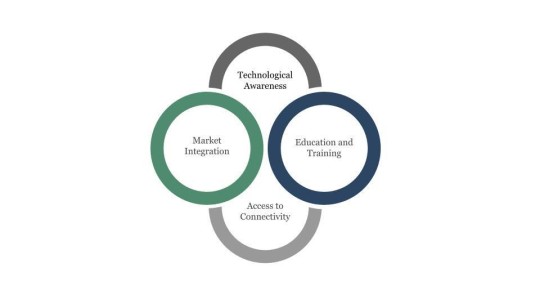
Challenges to Adoption:
Cost and Affordability: ERP implementation involves upfront costs for software licenses, hardware infrastructure, and training, which may be prohibitive for smallholder farmers with limited financial resources. While government subsidies or financing schemes can alleviate some of the financial burden, affordability remains a significant barrier to adoption for many farmers.
Complexity and Technical Support: ERP systems are sophisticated software solutions that require technical expertise for installation, customization, and maintenance. Many farmers, especially those with limited formal education or digital literacy, may find ERP interfaces complex and challenging to navigate without adequate technical support and guidance.
Infrastructure and Connectivity: In rural areas with poor infrastructure and limited internet connectivity, accessing and using ERP systems may be impractical or unreliable. Even with the increasing availability of mobile internet services, connectivity issues persist in remote agricultural regions, hindering farmers' ability to leverage cloud-based ERP solutions effectively.
Cultural and Behavioral Factors: Farmers' attitudes towards technology and traditional farming practices can influence their readiness to adopt ERP systems. Resistance to change, skepticism about the benefits of digitalization, and reliance on customary farming methods may impede the uptake of ERP technology, particularly among older or more conservative farmers.
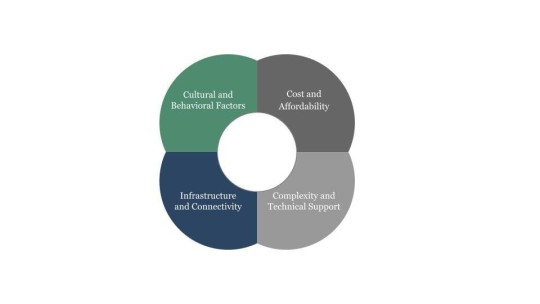
ERP Companies: Cultivating Solutions for Indian Needs
ERP companies can play a crucial role in accelerating ERP adoption in Indian agriculture. Here's how:
Localization is Key: Develop user interfaces and functionalities in local languages for better accessibility.
Mobile-First Approach: Prioritize mobile app development for real-time data access and on-field management.
Offline Functionality: ERP systems should function even in areas with limited internet connectivity.
Scalability and Affordability: Offer modular solutions with varying functionalities to cater to different farm sizes and budgets.
Partnerships: Collaborate with government agencies, NGOs, and agricultural institutions to promote digital literacy and build trust in ERP technology.
The Road Ahead: A Symbiotic Future
The future of Indian agriculture is one where ERP systems seamlessly integrate with a developing infrastructure. By embracing localization, mobility, and affordability, ERP companies can empower Indian farmers to make data-driven decisions, improve efficiency, and navigate the path towards a more sustainable and profitable future.
This collaborative effort between the government, ERP companies, and farmers has the potential to revolutionize Indian agriculture, ensuring food security for a growing nation and economic prosperity for its rural population.
How companies can expand in India’s unique ERP infrastructure landscape:
Understanding the Infrastructure:
Research and Analysis: Conduct in-depth research on the current state of internet connectivity, digital literacy levels, and farm sizes across different regions of India. Partner with local agricultural institutions or consulting firms to gain insights.
Focus on Regions: Identify regions with better digital infrastructure and higher tech adoption among farmers. This can help prioritize initial market entry and solution development.
Tailoring Your ERP Approach:
Localization is Paramount: Develop user interfaces and training materials in local languages to overcome language barriers and improve accessibility.
Mobile-First Development: Prioritize building mobile applications for your ERP system. This caters to the growing smartphone usage among farmers and allows for real-time data access and on-field management.
Offline Functionality: Ensure your ERP system functions even in areas with limited internet connectivity. This could involve data caching or offline modules for core functionalities.
Modular and Scalable Solutions: Offer various service tiers within your ERP system. This allows farmers with smaller land holdings or lower budgets to access basic functionalities, with the option to upgrade as their needs evolve.
Partnerships are Key: Collaborate with Indian companies or organizations. This can include:Technology Providers: Partnering with local IT firms can help integrate your ERP with existing agricultural platforms or government initiatives.Agricultural Institutions: Collaborate with agricultural universities or research bodies to offer training programs and build trust in your ERP technology among farmers.Non-Governmental Organizations (NGOs): Partnering with NGOs can help reach smallholder farmers and integrate them into the digital agricultural ecosystem.
Additional Considerations:
Data Privacy and Security: Ensure your ERP system complies with Indian data privacy regulations to build trust with farmers.
Focus on Value Addition: Go beyond basic functionalities. Highlight how your ERP system offers unique value propositions like improved yield management, market access, or financial planning tools.
By understanding the evolving infrastructure and tailoring your ERP solutions, foreign companies can position themselves for success in the Indian agricultural market. Remember, collaboration with local players and a focus on user-friendliness will be crucial for long-term growth.
About Global Launch Base:
Global Launch Base helps international startups expand in India. Our services include market research, validation through surveys, developing a network, building partnerships, fundraising, and strategy revenue growth. Get in touch to learn more about us.
Contact Info:
Website: www.globallaunchbase.com
LinkedIn: https://www.linkedin.com/company/globallaunchbase/
Email: [email protected]
#AgricultureERP hashtag#IndianAgricultureTechnology#hashtag#FarmManagementSoftware hashtag#AgriculturalDigitization#ERPSolutionsForFarmers hashtag#IndianAgriculturalInnovation#DigitalTransformationInFarming hashtag#AgriculturalSoftwareSolutions#ERPImplementationInAgriculture hashtag#AgriTechAdvancementsInIndia hashtag#indianfarmers hashtag#indianfarmer hashtag#india hashtag#erp hashtag#agriculture hashtag#indianews
0 notes
Text
0 notes
Link
Farmsio is expertized at Agriculture Supply Chain Management Solutions. Our Farm Management Software has been developed over the time-tested period bringing about efficiency in movement and cost optimization across all Agro Produce and products.
0 notes
Link
Farm management software by Ncrypted aims at the technology-intensive transformation of agriculture and agribusiness. Moreover, it enables you to you plan, screen and analyze all exercises of farmland on figure tips without any hassle. Planting, tillage, crop assurance, treatment, water system, procurement, supply chain, financial accounting and all different exercises can be managed within a couple of taps. Additionally, you can track expenses, input usage and work hours for each movement.
0 notes
Text
Farm Management Software Market Size, Share, Growth, Opportunities and Global Forecast to 2027
The new research report titled " Farm Management Software Market, Global Industry Analysis, and Forecast" gives a detailed analysis and future forecasts of the market. The report highlights the significant players, including market size, share, and demand, development. This report further covers the latest trends, technological advancements, and growth opportunities.
The research report also covers the comprehensive profiles of the key players in the market and an in-depth view of the competitive landscape worldwide. The major players in the farm management software market include AG Leader Technology, AgJunction, Deere & Company, Raven Industrie, Topcon Positioning Systems, Trimble, BouMatic, GEA Group, SST Development Group ,Iteris, DICKEY-john,The Climate Corporation, FARMERS EDGE, and DeLavalS. This section includes a holistic view of the competitive landscape that includes various strategic developments such as key mergers & acquisitions, future capacities, partnerships, financial overviews, collaborations, new product developments, new product launches, and other developments.
Get more information on "Global Farm Management Software Market Research Report" by requesting FREE Sample Copy at https://www.valuemarketresearch.com/contact/farm-management-software-market/download-sample
Market Dynamics
The rising implementation of cloud computing for real-time farm data management across the globe is the primary factor driving the farm management software market. Also, increasing adoption of site-specific crop management by the farmers to improve crop yields and get the necessary information for taking farm management decisions contributes to the farm management software market's growth. The adoption of remote sensing technology in the agriculture industry is positively impacting the farm management software market's growth. Moreover, the rising governments’ support to adopt modern agricultural techniques and high focus on monitoring livestock performance and health is likely to generate profitable growth opportunities for key players of the farm management software market in the coming years. The report covers Porter’s Five Forces Model, Market Attractiveness Analysis and Value Chain analysis. These tools help to get a clear picture of the industry’s structure and evaluate the competition attractiveness at a global level. Additionally, these tools also give inclusive assessment of each segment in the global market of farm management software.
Browse Global Farm Management Software Market Research Report with detailed TOC at https://www.valuemarketresearch.com/report/farm-management-software-market
Market Segmentation
This section of the farm management software market report provides detailed data on the segments by analyzing them grographically, thereby assisting the strategist in identifying the target demographics for the respective product or service. By Agriculture Type
Precision farming
Livestock monitoring
Smart greenhouse
Others
By Deployment Model
Web-based
Cloud-based
By Service
System integration & consulting
Maintenance & support
Managed services (Data services , Analytics services and Farm operation services)
Assisted professional services (Supply chain management services and Climate information services)
Regional Analysis
This section covers regional segmentation which accentuates on current and future demand for aerosol valve market across North America, Europe, Asia-Pacific, Latin America, and Middle East & Africa. Further, the report focuses on demand for individual application segment across all the prominent regions.
Purchase Complete Global Farm Management Software Market Research Report at https://www.valuemarketresearch.com/contact/farm-management-software-market/buy-now
About Us:
Value Market Research was established with the vision to ease decision making and empower the strategists by providing them with holistic market information.
We facilitate clients with syndicate research reports and customized research reports on 25+ industries with global as well as regional coverage.
Contact:
Value Market Research
401/402, TFM, Nagras Road, Aundh, Pune-7.
Maharashtra, INDIA.
Tel: +1-888-294-1147
Email: [email protected]
Website: https://www.valuemarketresearch.com
#FarmManagementSoftwareMarketSize#FarmManagementSoftwareMarketShare#FarmManagementSoftwareIndustryReport#FarmManagementSoftwareReport#FarmManagementSoftware#FarmManagementSoftwareMarket
0 notes
Text
Know the best Farm Accounting Practices using a Smart ERP Platform
Make your Agribusiness profitable with FarmERP: A smart agriculture ERP platform that consists of full feature powerful yet user friendly Accounts module, capable of handling financial transactions, accounts keeping and financial reporting.

#bestfarmmanagementsoftware#agriculturemanagementsystem#farmmanagementsoftware#organic farm management software#agriculture software solutions#plant nursery management software#plantation erp#organic farming software#Nursery management system
0 notes
Text
What is Farm Management Software Its Benefits And Features
Farm management software centralizes, manages, and optimizes the production activities and operations of farms.
The day to day farming activities in the present times has moved toward becoming progressively business-oriented. The framing process is considerably more than simply the production of good yields. It requires the farmers to address the issues of maximum returns, grains, processing, protection, sales, inventory and so forth.

#farmmanagementsoftware#feedmanagementsoftware#livestockmanagementsoftware#poultrymanagementsoftware#ERPmanagementsoftware
0 notes
Photo

A single ERP platform managing a wide range of agribusiness sub verticals: CATCHW8
#FarmManagementSoftware#ERPForAgriculture#AgriBusinessERP#ERPInAgriculture#CatchWeightERPForAgricultureIndustry
0 notes
Text
Agmatix: Revolutionizing Agriculture with Farm Management Software
Managing a farm is no small feat, and that's where Agmatix's advanced Farm Management Software steps in to make a difference. This innovative tool empowers farmers, agronomists, and agricultural businesses to streamline operations, optimize resources, and boost productivity.
Agmatix's farm management software offers a range of features, from real-time data monitoring to crop planning, soil analysis, and weather forecasting. It simplifies decision-making by providing actionable insights, helping you stay ahead in an ever-changing agricultural landscape.
Whether you’re a small-scale farmer or managing large agricultural enterprises, Agmatix delivers tailored solutions to meet your needs. The software's intuitive interface ensures ease of use while its powerful analytics drive smarter farming practices.
Discover how Agmatix's farm management software can help you increase yields, reduce costs, and contribute to sustainable farming. Experience the future of agriculture today!
#FarmManagementSoftware#Agmatix#SmartFarming#AgricultureTech#FarmOptimization#SustainableFarming#PrecisionAgriculture#CropManagement#FarmDataInsights#AgriSolutions
0 notes
Text
Farm Management Software Market presents strong revenue visibility
Competitive Insights: The leading players in market are Deere & Company, Trimble, AG Leader Technology, SST Development Group, AgJunction, and Raven Industries. The major players in the market are profiled in detail in view of qualities, for example, company portfolio, business strategies, financial overview, recent developments, and share of the overall industry.
Get Sample Copy of This Report @ https://www.crystalmarketresearch.com/report-sample/IC06864 .
The Farm Management Software Market is segmented as follows-
By Type: Precision Farming Livestock Monitoring Fish Farming Smart Greenhouse Farming
By Deployment Mode: Web-based Cloud-based
By Service Provider: System Integration & Consulting Maintenance & Support Assisted Professional Services Managed Services
Industry Outlook & Trend Analysis: The Farm Management Software market was worth USD 0.67 billion in 2014 and is expected to reach approximately USD 2.19 billion by 2023 at a CAGR of 14.14%.
As the world population is increasing continuously the demand for food is also rising. Hence an efficient way for farming and its management has to developed and used in order to fulfill the demands. Factors such as government initiatives to adopt modern farming techniques and management and rising focus on management of livestock are predicted to propel the market growth further.
For more information, click on the below link @ https://www.crystalmarketresearch.com/report/farm-management-software-market .
Table of Contents: 1.Introduction 2.Executive Summary 3.Market Overview 4.Market Analysis by Regions 4.1.North America (United States, Canada and Mexico) 4.2.Europe (Germany, France, UK, Russia, Italy and Rest of Europe) 4.3.Asia-Pacific (China, Japan, Korea, India, Southeast Asia and Rest of Asia-Pacific) 4.4.South America (Brazil, Argentina, Columbia and Rest of South America) 4.5.Middle East and Africa (Saudi Arabia, UAE, Egypt, Nigeria, South Africa and Rest of MEA) 5.Farm Management Software Market, By Type 5.1.Introduction 5.2.Global Farm Management Software Sales, Revenue and Market Share By Type (2014-2018) 5.2.1.Global Farm Management Software Sales and Sales Share By Type (2014-2018) 5.2.2.Global Farm Management Software Revenue and Revenue Share By Type (2014-2018) 5.3.Precision Farming 5.3.1.Global Precision Farming Sales and Growth Rate (2014-2018) 5.4.Livestock Monitoring 5.4.1.Global Livestock Monitoring Sales and Growth Rate (2014-2018) 5.5.Fish Farming 5.5.1.Global Fish Farming Sales and Growth Rate (2014-2018) 5.6.Smart Greenhouse Farming 5.6.1.Global Smart Greenhouse Farming Sales and Growth Rate (2014-2018) To be Continued...
Regional Outlook & Trend Analysis: According to the region, the Farm Management Software Market is segmented as North America, Asia-Pacific, Europe and Rest of World. The Asia-Pacific is predicted to grow lucratively with a significant CAGR during the forecast period. Japan and China are the dominant countries in the region which are making hefty investments in the R&D sections of farm management software. North America owing to government subsidies is expected to grow its farm management software market during the forecast period.
To avail discount, please click on the link @ https://www.crystalmarketresearch.com/check-discount/IC06864 .
About Crystal Market Research: Crystal Market Research is a U.S. based market research and business intelligence company. Crystal offers one stop solution for market research, business intelligence, and consulting services to help clients make more informed decisions. It provides both syndicated as well as customized research studies for its customers spread across the globe. The company offers market intelligence reports across a broad range of industries including healthcare, chemicals & materials, technology, automotive, and energy.
Contact Us: Judy 304 South Jones Blvd, Suite 1896, Las Vegas NV 89107, United States Toll Free: +1-888-213-4282 Email: [email protected]
0 notes
Text
Explore how Farm Management Software is revolutionizing agriculture in our latest blog, "The Future of Farming: How Farm Management Software is Transforming Agriculture." Learn how cutting-edge technology is driving efficiency, optimizing resources, and empowering farmers to make data-driven decisions. Whether you’re managing a small farm or a large-scale operation, this software is key to sustainable and profitable farming.
Don’t miss out on the innovations shaping the future of agriculture—read the full blog now!
#FarmManagementSoftware#AgricultureInnovation#AgTech#PrecisionFarming#SustainableFarming#FarmTech#Agmatix#FutureOfFarming#SmartFarming#DigitalAgriculture
1 note
·
View note
Link
In addition, Farmsio’s Farm Management Software (FMS) facilitates Agriculture credit sources. Farmers can choose the source of agricultural finance from Institutional or Non-Institutional Sources. advises farmers with the Climate Smart and Sustainable Agriculture practices, that is by redesigning the usage of farmland based on the soil ecosystem, integrating trees, and livestock thus reducing the dependency on farm inputs like pesticide and fertilizers. Farmsio helps farmers to overcome the economic impact of climate change and increase better farm output.
#farmmanagementsoftware#sustainableagriculture#ClimateSmartAgriculture#technologyforagriculture#agriculturesupplychainmanagement
0 notes
Link
Farmiso with extensive experience in Sustainable Agriculture Methods and Modern Digital technology for Agriculture expertise can ensure traceability and food safety throughout the food chain and work closely with the Food and beverage producers, processors to find the right tailor-made, result-oriented, traceability solutions.
#foodtraceability#agriculturesupplychainmanagement#carboncreditsfarming#digitalagriculture#technologyforagriculture#farmmanagementsoftware
0 notes
Photo

Over the past decade, international #agriculture transformation, food market linkage and the agro supply chain between the EU and Africa have been shifting rapidly towards better commercial systems. Agriculture has been the major business sector in the #Africaneconomy. Africa has been the potential producer of cash crops like cotton, tobacco, avocados, coffee, milk, peanuts, mangoes, timber, etc.
The development of the African Continental Free Trade Area (AfCFTA ), the government renewed investments & trade policies in the Agriculture sector, infrastructure, #AgroTechnologies, credit provision, #Climatesmartfarming, Sustainable Agricultural practices, etc. has resulted in increased production. The favourable business environment and better market linkage are promoting the strategic agro-export business opportunities between Africa to the EU.
identifies the market potential and addresses the challenges in the value chain, increases agriculture input accessibility, skill development to adopt sustainable farming practices and facilitate connecting the Smallholder farmers to the domestic and export commodity markets in Europe, Asia and Africa.
𝗥𝗲𝗾𝘂𝗲𝘀𝘁 𝗳𝗼𝗿 𝗮 𝗗𝗲𝗺𝗼:Website: https://farms.io
#technologyforagriculture#farmmanagement#foodtraceability#agriculturesupplychainmanagement#agriculturemonitoring#farmmanagementsoftware
0 notes
Photo

#FoodTraceability enables the food commodity producers & processing organisations to document the contents, stages of handling and movement of the food product in the value chain till the point of consumption.
Farmsio's End to end food traceability solution identifies and warns about food contamination, spoilage, spillage, pilferage, type and causes for contamination of the affected batch of food and protects consumers.
It enables the #foodsafety authorities to take timely action before the consumers are affected. The system regulated information enables the international commodity food products trading organisations to comply with the statutory stipulations.
𝗥𝗲𝗾𝘂𝗲𝘀𝘁 𝗳𝗼𝗿 𝗮 𝗗𝗲𝗺𝗼:Website: https://farms.io
#foodtraceability#agriculturesupplychainmanagement#technologyforagriculture#farmmanagementsoftware#farmadvisoryservices
0 notes